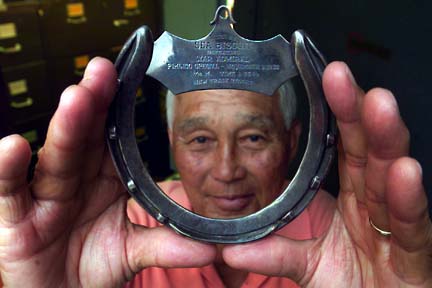
GEORGE F. LEE / GLEE@STARBULLETIN.COM
Eddie Hamada, retired Iolani School athletic director, shows the horseshoe worn by Seabiscuit donated to Iolani School for good luck.
Iolani’s lucky charm
When the movie "Seabiscuit" opens next week, the story of the puny but plucky racehorse that inspired a nation will reach a new generation. Some aging Iolani School alumni already know the horse well: They used to kiss his shoe.
Tucked in a vault at Iolani rests one of the horseshoes that Seabiscuit, a down-and-out horse with crooked forelegs, wore in his triumph over defending champion War Admiral on Nov. 1, 1938.
Seabiscuit's quest to become Horse of the Year transfixed Depression-weary Americans, winning him more press coverage than President Franklin Delano Roosevelt, Hitler or Mussolini that year, according to Laura Hillenbrand, author of "Seabiscuit: An American Legend."
Among his fans was Iolani's football coach, Father Kenneth Bray, who wrote to the horse's owner, Charles Howard, telling him how he used Seabiscuit's grit and tenacity to encourage his athletes. In response, Howard sent him one of the champion's shoes -- and a tradition was born.
The shoe from that famous race has been largely out of sight for half a century, but football players at Iolani once knew it intimately. Before every game, Bray pulled it out of his coat pocket and passed it around his players, asking them to kiss it, in hopes of infusing them with the courage of the underdog that overcame long odds.
"On the bus going to the game, Father Bray had everybody kiss the horseshoe," recalls former Iolani team member David Yamashiro, who graduated in 1951. "It wasn't so much for good luck, but to get you to play with your heart and your spirit.
"Although Seabiscuit was smaller than War Admiral, he ran with his heart and became the victor," Yamashiro said. "We came from a small school at that time. Iolani boys were smaller than the other teams', and our numbers were smaller, too. We had to play with our heart."
When the English-born Bray started coaching in 1932, Iolani's football team was a lackluster competitor in the junior varsity division of the Interscholastic League of Honolulu. In two years, the hard-driving coach moved his team up to the varsity level.
In 1939, the year after Seabiscuit's triumph, Iolani won the ILH football championship and played Punahou to a scoreless tie in the Thanksgiving Day game. The next year, the Raiders kept the championship, shutting out Saint Louis, 6-0, and went on to defeat Roosevelt High School in the Thanksgiving game.
Although World War II disrupted Iolani's winning streak as older students headed off to war, the horseshoe tradition continued for the coach, who specialized in using real-life stories to rally his troops.
Eddie Hamada, who played under Bray and graduated in 1946, said his mentor always managed to coax an extra ounce of effort out of his athletes.
"He told us to do the best you can with the ability that you have," said Hamada, who went on to follow Bray's footsteps as Iolani coach. "Work hard. Struggle, struggle, struggle.
"We could relate to it because Seabiscuit didn't win that many races, but he fought, fought, fought. He'd run hard, run tired. He showed a lot of courage."
When Bray died in 1953, the horseshoe was placed in Iolani School's archives.
Hamada tried bringing it out early on his coaching career in hopes of inspiring his own players. But he soon retired it to the archives, because he felt like he was treading on Father Bray's turf and couldn't measure up.
"I'm not even close to what Father Bray was," he said. "I was dreaming that I could get the same feeling that he did."
Every year, the shoe makes a cameo appearance at an Iolani reception before the Father Bray Football Classic, a preseason game that will be held Aug. 23 at Aloha Stadium against McKinley High School.
At commencement ceremonies last month, Seabiscuit's horseshoe hit the limelight again when Headmaster Val Iwashita held it aloft, urging graduates to "go forth, be the winners you are and run like the wind."
With the swirl of publicity over the movie and the opening of Iolani's new stadium next month, Iolani is considering giving the shoe a more public home.
"The school is looking into ways of displaying it," said Iolani spokeswoman Cathy Lee Chong.
In the meantime, Hamada and Yamashiro are headed to the movies, and urging their friends and family to do the same.
"What Seabiscuit did in terms of horse racing was just extraordinary," Hamada said. "It's a story that will keep coming back year after year."
